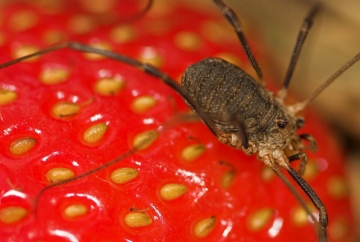Summary for Phalangium opilio (Opiliones)
previous species | next species
National Distribution
Terms of Use. Double-click on map to go to region

Explore Regional Distribution
Please log on and add a note on this species
About this species
Recorded altitude range0m to 415m
Species text
DistributionPhalangium opilio is a common and widespread species which becomes more coastal in Scotland. It is unclear when this species was first recorded in Britain but the first HRS record is from Glanvilles Wooton in Dorset prior to 1878.
It is widely distributed across Europe, including southern Sweden. It extends to North America and Asia and has been introduced to many parts of the world including New Zealand, readily stowing away in ships and aeroplanes.
Habitat and ecology
It occupies a wide range of mainly open, warm habitats including gardens, grassland, sand-dunes, brownfield sites, hedgerows and open woodland. It is not often found in heathland but is common around the coast. It is usually found in the lower layers of the vegetation but it is also worth searching walls and tree trunks. It has been recorded at up to 415m in Britain and to 2400m in the Apennines (Martens 1978).
Hillyard (2005) states that over most of Britain this species is adult from June and survives until December. HRS records show the first adults appearing in May (both sexes) and reaching a peak in September. Hillyard speculates that southern populations may have two generations in the year. Most juveniles are present from May to August and the eggs are laid the autumn, hatching in the spring. Clearly there is much to be learned about the life-cycle of this species especially in the south of its range e.g. whether juveniles overwinter. Wijnhoven (2009) notes the occurrence of two generations in the Netherlands.
It is very easy to see this species feeding as it is often active during the day. Several authors have recorded a long list of prey/food items across most invertebrate taxa and including vertebrate corpses.
Status
Common and widespread.
Text based on: Hillyard, P. D. 2005. Harvestmen: keys and notes for the identification of British species. Synopses of the British Fauna 4 (3rd edn). Field Studies Council, Shrewsbury.
References
Martens, J. 1978. Spinnentiere, Arachnida: Weberknechte, Opiliones. Die Tierwelt Deutschlands 64: 1-464. Fischer Verlag, Jena.
Wijnhoven, H. 2009. De Nederlandse hooiwagens (Opiliones) Naturalis Biodiversity Centre - Entomologische Tabellen, The Netherlands. (translation available here: http://srs.britishspiders.org.uk/portal/p/Harvestman+Resources)
References
Adult Season
Habitats
background methodology
Recorded management for locations with Phalangium opilio
Recorded substrate and hydrology for locations with Phalangium opilio
Images
please log on and upload a new image for this speciesSee also A-Z Species Index - A-Z Picture Index - previous species | next species





